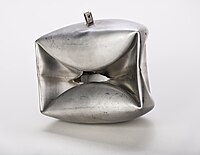
Photo from wikipedia
Abstract The fluid hammer phenomenon is a devastating incident that can cause substantial damages to the hydraulic systems. If the fluid reaches the vapor pressure due to high pressure gradients,… Click to show full abstract
Abstract The fluid hammer phenomenon is a devastating incident that can cause substantial damages to the hydraulic systems. If the fluid reaches the vapor pressure due to high pressure gradients, the phenomenon is called column separation. In this study, the overpressures and the column separation induced by the sudden closure of the valve are studied experimentally. To this end, an experimental apparatus consisting of copper and polyethylene tubes is built, and polyacrylamide (PAA) aqueous solution is used as the viscoelastic fluid. Experiments are carried out with water, fresh, and degraded PAA solutions at different concentrations of 100, 200, 300, and 400 ppm. Results indicated that the occurrence of the column separation in the copper tube is considerably impeded by implementing polymer additives. However, the influence is weakened significantly after degradation. On the other hand, this phenomenon in PE tubes is not as significant, because of the viscoelastic behavior of the pipe wall, which eliminates the abnormal pressure peaks, leading to a smoother pattern for the pressure wave. The overpressures are more remarkable in fresh polymer solutions at higher concentrations, and decreasing the concentration, as well as the degradation, mitigates them. Furthermore, the pressure wave rate of attenuation in the copper tube became 9.82% less substantial when the Deborah number increased from 6.59 to 9.21 (roughly 40%). Besides, this attenuation was 35.71, 62.00, 37.00, and 21.78% more severe in the degraded 100, 200, 300, and 400 ppm solutions than the corresponding fresh solutions, respectively. The pressure-time history in PE tubes with viscoelastic fluids followed a different trend. Also, the viscoelasticity has resulted in a decrease in acoustic wave speed as the wave speed in the 400 ppm solution is roughly 15.04% lower than water.
Journal Title: International Journal of Pressure Vessels and Piping
Year Published: 2021
Link to full text (if available)
Share on Social Media: Sign Up to like & get
recommendations!